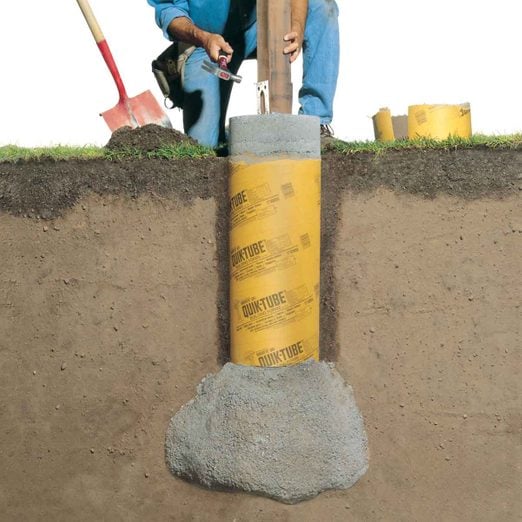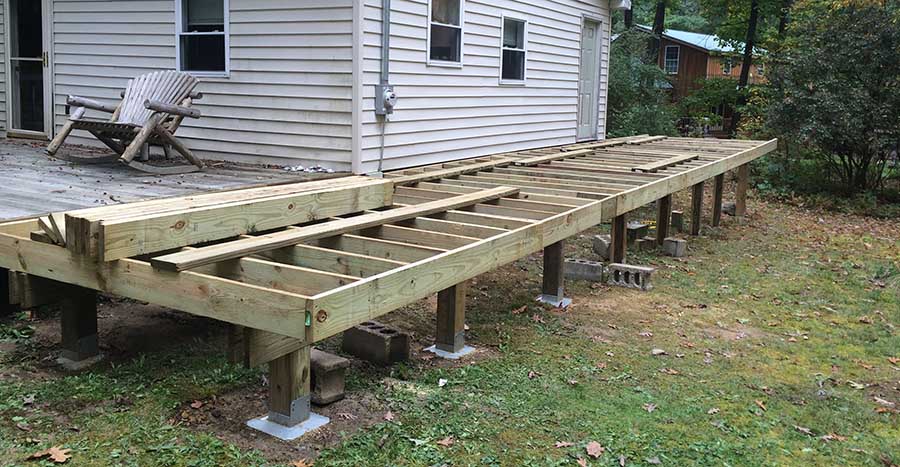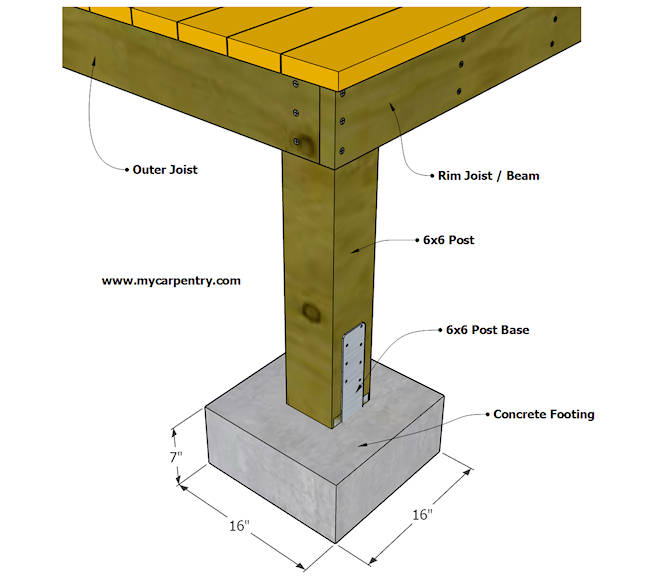Architectural Honesty Issues: Choosing the Right Deck Footings for Your Outdoor Project
Make Certain Stability and Long Life With Correctly Mounted Deck Footings
Deck grounds may not be the most glamorous aspect of deck building, however they play an essential duty in guaranteeing stability and durability. In this discussion, we will check out the value of appropriate deck footings, elements to think about during installation, various kinds of grounds offered, detailed setup guide, and maintenance tips for making certain durable grounds.

Relevance of Proper Deck Footings
Why are effectively installed deck grounds important for the security and longevity of your deck? The response hinges on the fundamental function that deck footings play in sustaining the weight of the whole structure. Deck footings are the foundation on which the deck relaxes, moving the tons from the deck to the ground. When footings are not effectively installed, it can bring about a variety of concerns that jeopardize the stability and durability of the deck.
Firstly, effectively mounted deck grounds distribute the weight of the deck evenly, stopping any type of unequal settling or sinking. This is particularly important in areas with unstable dirt, as it aids to minimize the danger of the deck collapsing or shifting. In addition, well-installed grounds make sure that the deck stays level, preventing any kind of architectural damage that can take place when a deck comes to be unequal.
Secondly, effectively set up footings provide a strong support for the deck, avoiding too much motion and persuade. This aids to preserve the structural honesty of the deck, minimizing the risk of injuries or mishaps. It also decreases the deterioration on the deck, allowing it to hold up against the aspects and regular usage for a longer amount of time.
Factors to Think About for Deck Footing Installment
When setting up deck grounds, there are a number of important variables to think about for correct setup. These factors can substantially affect the security and durability of your deck. Primarily, you require to figure out the sort of dirt on which the deck will certainly be built. Different dirt types have different load-bearing abilities, so it is important to conduct a dirt examination to guarantee the grounds can support the weight of the deck and its passengers. Additionally, the location and format of the deck should be thoroughly intended to stay clear of any type of challenges such as trees, energy lines, or underground pipes. It is likewise important to consider the regional environment and climate condition, as these can impact the durability of the footings. Areas with a high water table might call for additional procedures to stop water damages. Lastly, the size and material of the footings must be selected based on the dimension and weight of the deck, in addition to the regional building regulations and guidelines. By taking into consideration these variables, you can guarantee the appropriate installation of deck footings and take pleasure in a steady and resilient deck.
Kinds of Deck Footings to Pick From
There are a number of different kinds of deck footings available for you to pick from. Each type has its own benefits and drawbacks, so it's important to consider your specific requirements and the conditions of your deck prior to choosing.
One usual sort of deck ground is the concrete footing. This involves digging openings in the ground and putting concrete right into them to produce a solid foundation. Concrete footings are durable and provide excellent stability, making them ideal for decks in locations with difficult soil conditions or high wind loads.
An additional alternative is the helical pier ground, which is composed of a steel shaft browse this site with helical plates that are screwed into the ground. These footings are fast to mount and can be utilized in different soil types, including sandy or clay soils. They are also flexible, permitting for very easy progressing of the deck.
Sonotube grounds are another popular choice. These footings are developed by placing a cardboard tube in a hole and loading it with concrete. Sonotube grounds are reasonably simple to set up and supply appropriate stability for smaller sized decks or in locations with less requiring dirt conditions.

When choosing the type of deck footing, it's vital to consider factors such as soil conditions, deck size and weight, regional building regulations, and individual choices. By picking the appropriate footing type, you can guarantee the stability and longevity of your deck.
Step-by-Step Guide for Installing Deck Footings

Figure out the place: Start by marking the precise placement of each footing utilizing risks and string home (Deck Footings). Take into consideration any type of neighborhood building ordinance or policies relating to trouble ranges
Dig the holes: Use a post opening miner or an auger to dig the holes for the footings. Typically, a depth of at least 36 inches is advised for stability.
Level the holes: Guarantee that all-time lows of the openings are degree (Deck Footings). This can be attained by making use of a level or a straight board across the top of the holes
Add gravel: Place a layer of gravel at the bottom of each hole to improve drainage and avoid the footing from sinking into the soil gradually.
Place the footing types: Place the footing forms into the holes, ensuring they are focused and degree. Usage risks to protect them in position.
Mix and pour concrete: Comply with the directions on the concrete mix bag to prepare the concrete. Pour the concrete into the footing forms, loading them entirely.
Smooth the surface area: Make use of a trowel to smooth the surface area of the concrete and eliminate any type of air pockets. Enable the concrete to cure according to the producer's directions.
Maintenance Tips for Long-lasting Deck Footings
Proper upkeep is important for making sure the durability and stability of deck footings. By on a regular basis evaluating and keeping your deck footings, you can avoid damage and possible safety and security threats. One vital element of maintenance is to frequently look for any indicators of damage, such as splits or activity in the grounds. It is crucial to address them promptly to avoid more damages. if you observe any type of issues.
Regular cleansing is also essential for keeping deck footings. Dirt, vegetation, and particles can gather around the grounds, which can lead to moisture build-up and degeneration. Cleansing the footings routinely, using a brush or a stress washing machine, can help protect against these concerns and prolong the lifespan of your deck.
In enhancement to cleansing, it is essential to maintain the area around the grounds clear of any type of blockages. Avoid stacking products versus the footings or allowing plants to expand also near to them. These blockages can catch moisture and trigger the footings to wear away over time.
Lastly, normal resealing of the grounds is recommended to secure them from dampness and other environmental elements. Applying a water-proof sealer can aid prevent water damage and extend the life expectancy of the grounds.
Final Thought
Finally, correct installment of deck grounds is critical for ensuring stability and longevity of your deck. Factors such as soil kind, lots ability, and neighborhood building ordinance require to be thought about when selecting the best sort of deck grounds. Adhering to a detailed guide for installation and regular upkeep will certainly assist to guarantee the footings remain durable and long-lasting.
In this conversation, we will explore the importance of proper deck grounds, variables to take into consideration throughout installment, various types of footings available, step-by-step installment overview, and maintenance ideas for making sure lasting footings. find out here Deck grounds are the structure on which the deck relaxes, transferring the load from the deck to the ground.One typical type of deck ground is the concrete ground. Insert the ground forms: Put the footing forms right into the holes, guaranteeing they are centered and degree.In conclusion, correct setup of deck grounds is critical for making sure stability and durability of your deck.